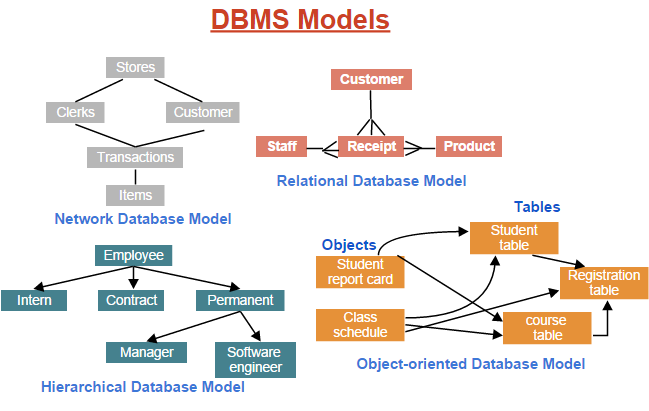| Definition | Proposed By | Function | Advantages | Disadvantages |
| Network Model | Network model viewed as a graph where entities form relationships or we can say this is flexible approach to represent the object and their relationships and the relationships between two nodes or objects are associated with arc. | This model is developed by the conference on Data Systems Languages Consortium with standard specification in 1969. | This model provides a data management language that define data characteristics and the structure to manipulate the data. Definition language use schema and subschema languages which enable database administrators to fine schema components and allow application program to define database components which we are going to use. | Advantage-simple concept, ability to manage more relationship types, easy access to data, data integrity, data independence. | system complexity, Functional Flaws, Lack of structural Independence. |
|---|
| Relational Model | This method is to structuring data using relationships which are grid like mathematical representation emphasis of columns and rows. This concept is heavily comes from mathematics because this term generally use domain, ranges and unions. | Proposed by E.F. Codd in 1969 | all data type is scalar that are represented in the rows and column format, it follow the property of closure as all the operation are performed on the entire relationships and result is also compiled like same collectively. | Data stored once complex queries can be carried out, better security, cater for future requirements and ease of design, maintenance, implementation and usage. | Hardware overheads, easy of design may lead to bad design, information island can create data duplication, data inconsistency, data redundancy and so on. |
|---|
| Entity-Relationship Model | This model is a way to represent the logical relationships of entities to create any database. Basically entities are nouns like employee, department, product or network. | The model proposed by Peter Pin-Shan Chan of (MIT) in 1970s. | | Straight forward relation representation, easy conversion from E-R to another data model, graphical representation for better understanding, highly integrated with relational model and conceptually simple. | No industry standard for notation, popular for high-level design, loss of information constraints, limited relationship representation and no representation of data manipulation. |
|---|
| Object-Oriented Model | This model provides all the facilities associated with object oriented paradigms along with it also provide facilities with standard database systems. This model also enable to create classes, objects, structure an inheritance hierarchy and call methods of other classes. In commercial business application object oriented database systems have not replace RDBMS yet. | Object Database have been considered since the early 1980s which are different from relational database that are table oriented. | According to industry trend this model provide integration and sharing. Integration of operating systems, databases, languages, spreadsheet and sharing of data, information, software components, products and it also provide referential sharing to multiple applications and products. | Enriched modelling capabilities, Extensibility, capable of handling large variety of database, removal of impedance mismatch, more expressive query language, support for schema evolution, support for long duration transaction and improved performance. | Lack of universal data model, lack of experience, lack of standards, competition, complexity, lack of support for views and lack of support for security. |
|---|
| Hierarchical Database Model | This database model use one to many relationship method for the data elements. This database is basically tree like structure that link the number of data elements from one parent to child which is considered as the primary record. | Hierarchical DBMSs were popular from the late 1960s, with the introduction of IBM' Information Management System (IMS) DBMS, through the 1970s. | | One of the advantage of this model is easy addition and deletion of new information, Data at the top position is very easy to access. As the model work with the linear data type then it is very easy to work with such model. The model related to real life hierarchies such as employee record in organization. | Complex implementation, predefined tree structure reduce flexibility, difficult to manage. |
|---|



